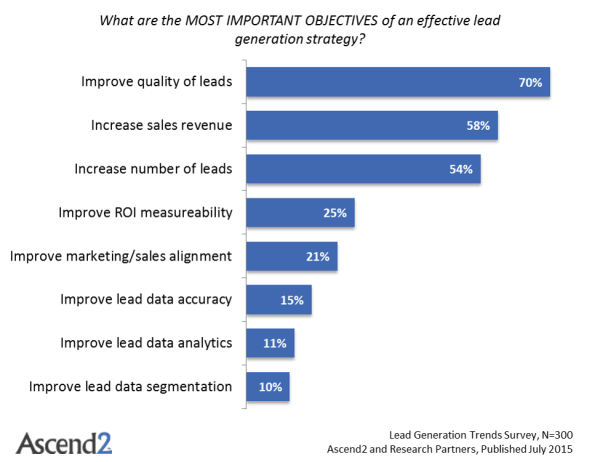70% of B2B Marketers Want More Quality Leads
The battle between quality and quantity seems to occur over and over in our lives, especially for B2B marketers. Whether we are talking about content, customers, or leads, there it is.
It even happens when we plan out our workday, decide what to eat, and choose where to go on vacation. Do you want to get more done, but not the most important things? Do you want more food, but fewer exquisite experiences? And do you want to return from vacation so tired from seeing so many things, or having had a handful of truly transcendent moments?
Since we are marketers, let’s focus on leads. We will leave the philosophical wrangling of our lives for another time.
What B2B Marketers Value in a Lead Gen Strategy
B2B marketing is all about generating leads. Because many B2B sales cycles can be lengthy, leads are the best indicator of future sales success. Whether you call it a funnel, a journey, or a loop, prospects that become leads have raised their hands and expressed some interest in what your B2B company does, makes, or provides.
Leads are so important to B2B marketing that research firms study them all the time. And this battle between quality and quantity unwittingly shows up in these studies.
According to a recent study by Ascend2, 70% of B2B marketers cite improving the quality of leads as the most important objective of a lead generation strategy.

That’s right. Seven out of 10 marketers in this survey have said the most important part of their lead generation strategy is to get better quality leads. I’ll say it one more time: Getting better leads is part of their strategy.
But if we look at the third most important objective of this study, cited by 54% of those marketers surveyed, it is increasing the quantity of leads generated. Wait—so more than half of them just want more leads?
How can the quality of leads be the most important and the quantity not be that far behind? The answer has to do with the culture of the organization and what metrics are important to executives.
Marketers who say quality of leads are the most important are those who have connected their lead generation efforts to their sales pipeline metrics. This kind of marketing and sales alignment has become more common with the shifts that digital marketing has caused in this relationship. It doesn’t take long to discover that as lead quality increases, so does its impact on the sales pipeline.
Quality Over Quantity
Those who are interested in more leads are the marketers who don’t have their metrics house in order. Executives demand more leads, but they are not connecting the dots with its impact on sales. Of course more leads are required to increase sales. But as they will find out once their metrics reach a certain level of maturity, that’s not true if they are not attracting the right prospects.
The takeaway for B2B marketers is that they need to follow the lead (pun intended) of these marketers surveyed and focus on attracting the right prospects for their company. It’s not just about the number of leads. Whether you determine who your quality prospects are with the types of content consumed, a lead scoring model, or a true end-to-end reporting structure from marketing to sales, this is now a requirement of modern marketing.
This post originally appeared on Convince & Convert.
